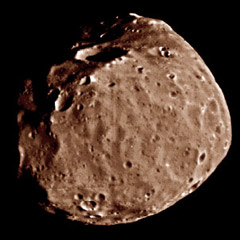 |
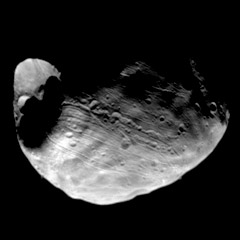 |
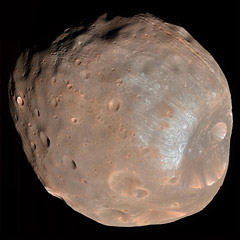 |
||
| Viking spacecraft image of Mars' moon Phobos showing craters (NASA/JPL) |
Viking spacecraft image of Phobos showing large Stickney crater on the left (NASA/JPL) | Mars Global Surveyor image of Phobos showing light colored material (NASA/JPL) |
| Back to Previous Stop | Return to Mars |
Phobos | Continue Tour to Deimos |
Continue to Next Stop |
Chariot of Fear
Phobos [FOH-bohs] is the innermost of Mars' moons and is the largest. It is closer to its planet than any other moon in the Solar System. It is also one of the smallest moons in the Solar System. Phobos was named after Fear, one of the charioteers of the Roman god, Mars. In Greek mythology, Phobos is one of the sons of Ares (Mars) and Aphrodite (Venus). Phobos and its cousin, Deimos, were discovered in 1877 by American astronomer Asaph Hall while observing Mars at the U.S. Naval Observatory in Washington.
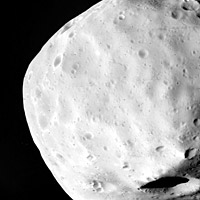 |
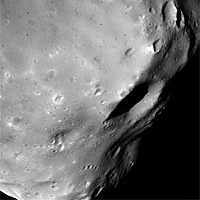 |
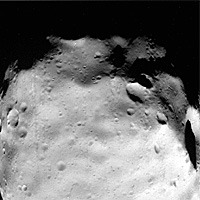 |
||
| Viking spacecraft image of Phobos showing craters (NASA/JPL) |
Viking image of Phobos showing Hall crater on the right (NASA/JPL) |
Viking spacecraft image of Phobos showing craters (NASA/JPL) |
A Tiny Moon
Phobos is a tiny moon. At only 16.8 miles (27 km) in length, it is the larger of Mars' two moons. At a distance of 5826 miles (9380 km) from Mars, Phobos appears as no more than a tiny, bright dot in the Martian sky. It is so close to Mars that it cannot be seen above the horizon from all points on the planet. Because it is so close, it takes a little more than 7 hours to orbit Mars. This moon has a highly irregular shape, looking more like an asteroid than a moon. In fact, some astronomers believe that it may have been a large asteroid that was captured by the gravitational pull of Mars. Others have found evidence that contradicts this theory.
We may never know exactly where this moon came from, or why it has such a strange shape. An interesting feature of Phobos is the fact that it appears to revolve around Mars in the opposite direction as its cousin Deimos. Both moons revolve in the same direction, but Phobos revolves in less than eight hours, only 1/3 the time it takes Mars to rotate on its axis. Phobos orbits Mars more than twice during each Martian day! This is because it orbits below the synchronous orbit radius of Mars. Because its orbit is so low, tidal forces are causing its orbit to get lower every year. In about 50 million years, Phobos will either crash into the surface of Mars or be broken up into a ring.
Features of Phobos
Phobos is a rather unremarkable object. It is essentially just a large rock potted with several craters. The largest is named Stickney, after discoverer Asaph Hall's wife. This huge gash is six miles wide, nearly 1/3 the size of the moon itself! Two other large craters are named Hall and Roche. These are about half the size of Stickney. Several other smaller craters dot the moon's surface with an average size of 500 feet (152 meters). Another interesting feature found on Phobos is the presence of surface fractures. These were probably caused by the giant impacts that formed the large craters, or from the strong gravitational effects of Mars.
Phobos is believed to be composed of carbon-rich rock like that found in C-type asteroids that exist in the outer asteroid belt. Due to the moon's low density, however, it is unlikely to be pure rock. It is probably composed of part rock and part ice. The Soviet spacecraft, Phobos 2, detected some type of gas being ejected from Phobos. Astronomers are not sure what is causing this, but the best theory suggests water may be escaping from the moon's interior. Phobos has no atmosphere and no magnetic field.
An Uncertain Future
Because Phobos orbits so close to Mars, gravity is continually pulling it closer to the planet. It is believed that it will one day crash into Mars, possibly in as little as 10 million years. Once Phobos gets down to an altitude of only 2,250 miles (3,620 km) above the surface of Mars, it will enter what's known as the Roche limit. At this point, the tidal forces of Mars will begin to tear the small moon apart. When this happens, it may eventually turn it into a small ring that will continue to spiral into the planet.
The Sun
Mercury
Venus
Earth
Mars
Jupiter
Saturn
Uranus
Neptune
Pluto
Asteroids
Comets
Interstellar Space
Your Weight on Other Planets
|
||||||||
| Back to Previous Stop | Return to Mars |
Return to Top of Page |
Continue to Next Stop |



